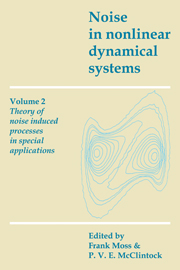Book contents
- Frontmatter
- Contents
- List of contributors
- Preface
- Introduction to Volume 2
- 1 Stochastic processes in quantum mechanical settings
- 2 Self-diffusion in non-Markovian condensed-matter systems
- 3 Escape from the underdamped potential well
- 4 Effect of noise on discrete dynamical systems with multiple attractors
- 5 Discrete dynamics perturbed by weak noise
- 6 Bifurcation behavior under modulated control parameters
- 7 Period doubling bifurcations: what good are they?
- 8 Noise-induced transitions
- 9 Mechanisms for noise-induced transitions in chemical systems
- 10 State selection dynamics in symmetry-breaking transitions
- 11 Noise in a ring-laser gyroscope
- 12 Control of noise by noise and applications to optical systems
- 13 Transition probabilities and spectral density of fluctuations of noise driven bistable systems
- Index
7 - Period doubling bifurcations: what good are they?
Published online by Cambridge University Press: 05 January 2012
- Frontmatter
- Contents
- List of contributors
- Preface
- Introduction to Volume 2
- 1 Stochastic processes in quantum mechanical settings
- 2 Self-diffusion in non-Markovian condensed-matter systems
- 3 Escape from the underdamped potential well
- 4 Effect of noise on discrete dynamical systems with multiple attractors
- 5 Discrete dynamics perturbed by weak noise
- 6 Bifurcation behavior under modulated control parameters
- 7 Period doubling bifurcations: what good are they?
- 8 Noise-induced transitions
- 9 Mechanisms for noise-induced transitions in chemical systems
- 10 State selection dynamics in symmetry-breaking transitions
- 11 Noise in a ring-laser gyroscope
- 12 Control of noise by noise and applications to optical systems
- 13 Transition probabilities and spectral density of fluctuations of noise driven bistable systems
- Index
Summary
Prologue
The statement that systems near the onset of instabilities are sensitive to fluctuations may be a haggard cliche, but is true nevertheless. The very notion of ‘instability’ means that a small fluctuation tends to grow with time rather than decay away. This has some distinct disadvantages, as was driven home to me during an experiment performed by Bob Miracky on an electrical circuit. Our goal was to determine the precise parameter value at which a period doubling bifurcation occurred, in order to compare this with analytic results derived from the circuit equation. As an experimental matter, this turned out to be tricky due to some curious interactions of the circuit with unwanted electrical noise.
Figure 7.1 reproduces a typical sequence of power spectra generated by sweeping a control parameter. If one has a good machine, the power spectrum is a very accurate means for determining the onset of period doubling bifurcations: the signature is the birth of a sharp spectral line at one-half the fundamental oscillation frequency ω0, this line initially growing from zero height. Figure 7.1(a) shows the system well below the bifurcation point; however, in addition to the expected lines at frequencies ω = 0 and ω = ω0 there appear two bumps in the broadband noise. Though mysterious, these bumps are not a problem since they are far away from the crucial frequency ω0/2. Unfortunately, as the bifurcation point is neared these bumps move together, eventually colliding at ω0/2 and obscuring the onset of the sharp line heralding the bifurcation.
- Type
- Chapter
- Information
- Noise in Nonlinear Dynamical Systems , pp. 145 - 178Publisher: Cambridge University PressPrint publication year: 1989
- 4
- Cited by



